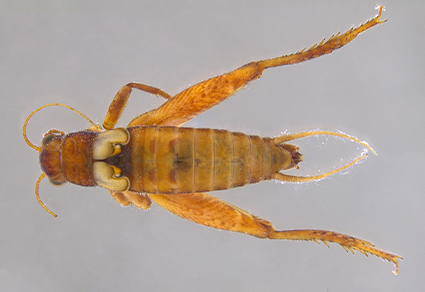Abstract
Odontogryllini is a tribe of ground-dwelling crickets exclusive to America. After several taxonomic rearrangements, this tribe has five genera and 23 species now placed in the subfamily Landrevinae. These crickets have dorsoventrally depressed bodies and are moderately to densely covered with bristles. The males may bear tegminal, metanotal, or tergal glands. In this contribution, we discuss the taxonomic status and the morphological features of Odontogryllini and the other two tribes of Landrevinae: Landrevini and Prolandrevini. The presence of dorsal spines between the outer spurs of the hind tibia distinguishes Odontogryllini from Prolandrevini, and the straight or slightly arcuate but never S-shaped stridulum from Landrevini. We also propose the enlarged and plate-like rami as a diagnostic characteristic to distinguish Odontogryllini from Landrevini. Additionally, we describe a new species of the genus Xulavuna de Mello & Campos from the Brazilian Amazon Rainforest, named Xulavuna krenakore sp. nov..
References
- Béthoux, O. (2012) Grylloptera – a unique origin of the stridulatory file in katydids, crickets, and their kin (Archaeorthoptera). Arthropod Systematics & Phylogeny, 70, 43–68. https://doi.org/10.3897/asp.70.e31747
- Campos, L.D. de & de Mello, F. de A.G. (2014) Taxonomic studies on the Neotropical Landrevinae with description of new taxa (Orthoptera, Grylloidea, Gryllidae). Zootaxa, 3852 (2), 151–178. https://doi.org/10.11646/zootaxa.3852.2.1
- Chamorro-Rengifo, J., Braun, H. & Lopes-Andrade, C. (2014) The secret stridulatory file under the right tegmen in katydids (Orthoptera, Ensifera, Tettigonioidea). Zootaxa, 3821 (5), 590–596. https://doi.org/10.11646/zootaxa.3821.5.7
- Cigliano, M.M., Braun, H., Eades, D.C. & Otte, D. (2023) Orthoptera Species File. Available from: https://orthoptera.speciesfile.org/ (accessed 28 December 2023)
- Desutter-Grandcolas, L. (2003) Phylogeny and the evolution of acoustic communication in extant Ensifera (Insecta, Orthoptera). Zoologica Scripta, 32, 525–561. https://doi.org/10.1046/j.1463-6409.2003.00142.x
- Desutter, L. (1987) Structure et évolution du complexe phallique des Gryllidea (Orthoptera) et classification des genres Nétropicaux de Grylloidea, Première Partie. Annales de la Société entomologique de France, New Series, 23, 213–239. https://doi.org/10.1080/21686351.1987.12278443
- Desutter, L. (1988) Structure et évolution du complexe phallique des Gryllidea (Orthoptèra) et classification des genres Nétropicaux de Grylloidea - Deuxième Patie. Annales de la Sociét Entomolologique de France, 24, 343–373. https://doi.org/10.1080/21686351.1988.12277541
- Gorochov, A.V. (1982) A new cricket subfamily (Orthoptera, Gryllidae) from Indo-Malayan region. In: Medvedev, L.N. (Ed.), Animal World of Vietnam. Nauka, Moscow, pp. 147–151.
- Gorochov, A.V. (2001) Preliminary notes on the history of south american Ensifera (Orthoptera). Acta Geologica Leopoldensia 24, 81–86.
- Gorochov, A.V. (2004) Review of the subfamily Pteroplistinae (Orthoptera Gryllidae). Memorie of Scociety entomological Italian, 82, 379–396.
- Gorochov, A.V. (2013) New species of the Neotropical genus Odontogryllus Saussure (Orthoptera: Gryllidae: Landrevinae). Proceedings of the Zoological Institute RAS, 317, 136–150. https://doi.org/10.31610/trudyzin/2013.317.2.136
- Gorochov, A.V. (2016) Taxonomic studies on the subfamily Landrevinae (Orthoptera: Gryllidae). Zoosystematica Rossica, 25, 23–97. https://doi.org/10.31610/zsr/2016.25.1.23
- Gorochov, A.V. (2023) New data on the tribe Odontogryllini (Orthoptera: Gryllidae: Landrevinae) from America. Proceedings of the Russian Entomological Society, 94, 97–105. https://doi.org/10.47640/1605-7678_2023_94_97
- Gorochov, A.V. (2000) New and little known Landrevinae (Orthoptera: Gryllidae). Zoosystematica Rossica, 8, 267–280.
- Jaiswara, R., Souza-Dias, P.G.B., Campos, L.D. de, Redü, D.R., de Mello, F. de A.G. & Desutter-Grandcolas, L. (2018) Titanogryllus n. gen., the largest Gryllinae cricket from the Neotropical Region with three new species from the Brazilian Atlantic Forest (Orthoptera, Grylloidea, Gryllidae). Zootaxa, 4402 (3), 487–507. https://doi.org/10.11646/zootaxa.4402.3.4
- de Mello, F. de A.G. (1992) Five new Brazilian crickets and a new tribe for the Neotropical members of the subfamily Pteroplistinae (Orthoptera, Gryllidae, Pteroplistinae, Odontogryllini). Transactions of the American Entomological Society, 118, 147–158.
- Otte, D. & Alexander, R.D. (1983) The Australian Crickets (Orthoptera: Gryllidae). 1st Edition. Allen Press, Philadelphia, Pennsylvania, 477 pp. [http://books.google.com/books?id=PkvoRnAM6WUC&pgis=1]
- Saussure, H. (1877) Mélanges orthoptérologiques. Vme Fascicule. Gryllides. Mémoires de la Société de Physique et d’Histoire Naturelle de Genève, 25, 169–504.


